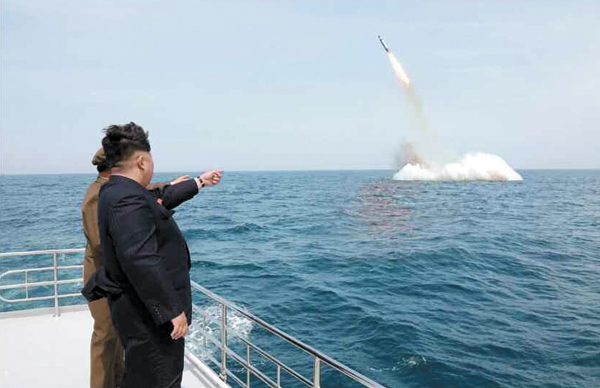North test-fires its first missile from a submarine

North Korean leader Kim Jong-un, right, observes the test-firing of a submarine-launched ballistic missile in a photo released by the Rodong Sinmun on Saturday. [Rodong Sinmun]
The North’s official Korean Central News Agency (KCNA) reported on Saturday that it had successfully test-fired a ballistic missile from a submarine in an undisclosed underwater location.
North Korea deployed a newly constructed 2,000-ton submarine to shoot the missile, according to the Seoul source. It was able to test out a new vertical launcher that allows it to fire a ballistic missile from a submarine.
“The test-fire carried out on May 8 was not of a missile but a dummy, so it was not revealed how far the missile would fly. However, the ejection test seems to have been successful as was revealed in the Rodong Sinmun on May 9,” the government official told the JoongAng Ilbo.
“North Korea recently test-fired on ground two to three times and then immediately loaded and fired from submarines, showing they are developing their SLBM considerably quick,” he said.
The Rodong Sinmun, the state-run newspaper of the North Korean Workers’ Party, ran a photo on Saturday of the missile labeled “Bukkeukseong-1,” which translated to “Polaris-1,” in red letters on its white surface.
After testing the vertical launcher on the ground last year, Pyongyang then moved it under the sea to try it out, marking the first time for Pyongyang to test-fire a ballistic missile from a submarine.
Because North Korean leader Kim visited the Sinpo South Shipyard on the east coast on Friday to oversee a fishery complex, according to state media, South Korean analysts suggest that the testing of the ballistic missile, also called KN-11, took place near the area.
Intelligence officials from Seoul and Washington are closely observing the development process of North Korea’s vertical launch system and recently detected that the launcher was installed in a submarine base near the port city of Sinpo, South Hamgyong, apparently in preparation for a launch.
Observers are concerned it may level up the North’s naval capabilities up to a decade ahead of South Korean naval strike abilities.
The KCNA said that the test “verified and confirmed that the underwater ballistic missile launch from a strategic submarine fully achieved the latest military, scientific and technical requirements.”
While officials in the South said the North’s submarine-launched missile was more of an ejection test, security experts here are concerned that Pyongyang is getting close to completing an operational SLBM after deploying its new submarine last November.
After a test launch from a vessel or submarine, it is estimated to take under a year and a half to become fully functioning and dispatchable to the military.
On Saturday, Pyongyang further test-fired three anti-ship missiles identified by military officials as its KN-01 cruise missiles off the ocean near Wonsan into the East Sea over the course of an hour between 4:25 p.m. and 5:23 p.m., according to South Korea’s Joint Chiefs of Staff (JCS).
The JCS identified the new anti-ship missile missiles as KN-01, like the one test-fired in February by Pyongyang, which has also been monitored by North Korean leader Kim Jong-un.
Military experts say that Pyongyang’s 2.3-ton KN-01, which has a range of more than 100 kilometers, is an improved version of China’s Silkworm ground-to-ship missile. It is estimated to be 5.8 meters long with a diameter of 76 centimeters.
On the same day, the Blue House convened an emergency meeting of the South Korea National Security Council, including national defense, foreign affairs and unification ministers, to analyze Pyongyang’s SLBM test and the risk of attack from the North.
The meeting, headed by Kim Kwan-jin, the Blue House national security office chief, also came amid recent threats from Pyongyang after it claimed South Korean vessels in the Yellow Sea had violated its borders. The North said it would strike down any South Korean naval vessels that illegally crossed into its waters without prior notice.
The Northern Limit Line (NLL) in the Yellow Sea is the de facto maritime border between the two countries, drawn unilaterally by the U.S.-led United Nations forces at the end of the 1950-53 Korean War.
In response, Adm. Choi Yun-hee, the chairman of the Joint Chiefs of Staff (JCS), on Saturday vowed to “protect the Northern Limit Line (NLL).” He met with U.S. Forces Korea commander Gen. Curtis Scaparrotti the previous day to discuss Pyongyang’s threats and come up with countermeasures.
The South’s navy also plans to build six 3,000-ton submarines equipped with vertical missile launchers between 2027 and 2030.
The U.S. State Department said Sunday that launches using ballistic missile technology were a “clear violation” of United Nations Security Council resolutions.
BY JEONG YONG-SOO, SARAH KIM [kim.sarah@joongang.co.kr]










with the Korea JoongAng Daily
To write comments, please log in to one of the accounts.
Standards Board Policy (0/250자)